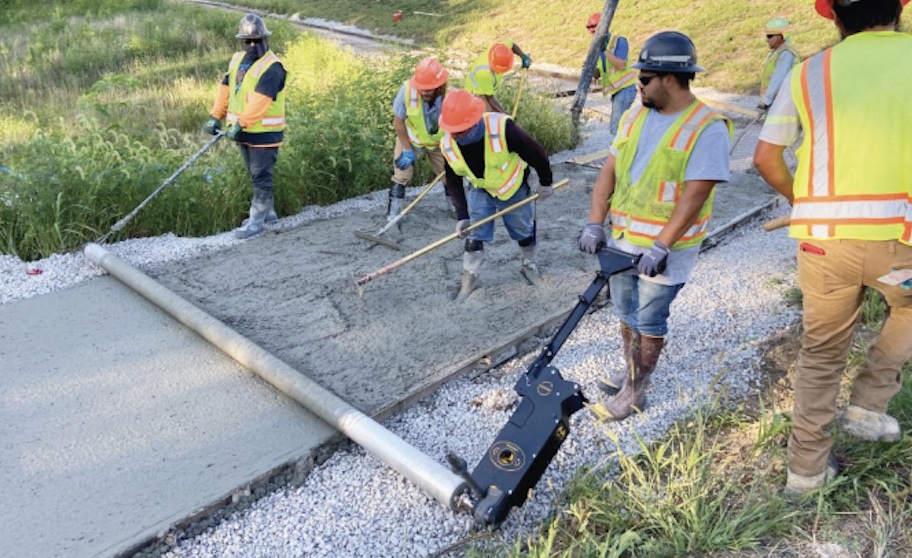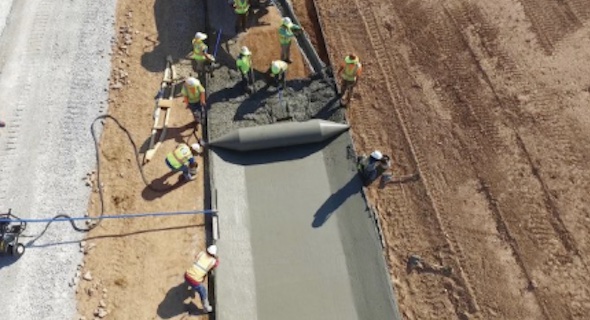
Features
Roads & Paving
Technology
Exploring screed options
January 11, 2023 By Seth Ulmer, sales manager, curb roller manufacturing

How to choose a concrete screed
For concrete contractors, screeds are an essential purchase and a critical tool for providing the smooth, level finish for concrete work. By carefully considering the screed types available, contractors can see maximum productivity from their investment. The most common screed categories include roller, truss, laser, power and hand screeds. Each screed has unique features that, when aligned with project goals, can improve ROI.
Here is a breakdown of the features, benefits and drawbacks of the most widely available screeds on the market.
ROLLER SCREEDS FOR VERSATILITY
Roller screeds broadly consist of a detachable pipe connected to a drive head with an extended handle for upright, ergonomic operation. These screeds are known for their minimal setup, low learning curve and the consistent, quality results they provide, with less reliance on the operator’s skill level. Roller screeds use a spinning motion to move concrete, a method that reduces operator fatigue and allows for improved integration of aggregate throughout the pour compared to vibratory methods that cause the aggregate to settle. These screeds are versatile and can be used for a variety of pours, often up to 22- to 30-feet wide, depending on the power source.
The roller screed’s detachable design also makes for a highly portable option when compared to bulkier and heavier screeds like a laser screed. Some manufacturers even offer linkable pipe sections to increase portability and versatility. General features like a three-way adjustable and lockable handle for improved ease of operation and a kickstand to keep the drive head and handle out of the concrete allow crews to quickly adapt to various jobsite needs. Contractors have four different power options to choose from: battery, corded, hydraulic and gas powered.
Battery-powered roller screeds are easily maneuverable and can handle pours up to 22-feet wide. These versatile machines can be especially useful for contractors working in basements or factory settings indoors, at farms, or communities in remote locations.
Depending on the slump and pipe length, a contractor can screed off 1,800 to 2,500 square feet of concrete with just one fully charged battery. Since the battery operation provides fume-free screeding for those working in any closed-off environment where fumes may be a concern, no additional power source such as gasoline, hydraulics or a generator is required. That means fewer transportation needs, reduced setup time and no cords or hoses in the way. Some battery-powered roller screeds can also provide cross-platform use by utilizing the same rechargeable 60-volt lithium-ion battery that is found in common handheld power tools.
For special projects such as circular pours, battery powered roller screeds provide a convenient single push-button directional change. This allows contractors to easily change their screeding direction to avoid cold joints or other structural flaws that can occur when concrete cures unevenly. Other screed types may require a complete disassembly, drive head rotation and reassembly of the screed to reverse direction.
Despite all the conveniences battery powered roller screeds offer, if power accessibility isn’t a concern or portable jobsite generators are abundant, some contractors may opt for a corded screed.
Corded electric roller screeds enjoy many of the same benefits and capabilities as battery powered roller screeds. They are fume-free for indoor jobs and some provide a single push-button directional change for screeding unique pours. With a nearby outlet or reliable generator, contractors can have the reassurance and convenience of seemingly endless power.
While enjoying the convenience of power, contractors must consider proper care to ensure the cords don’t become tangled, unplugged or damaged while on the jobsite. And relying on a separate power source, like a generator, can come with its own worries. That can include staying on top of fuel availability, general maintenance or fume concerns.
Battery and corded power can offer an immensely convenient and versatile screeding solution to any contractor’s fleet. But some heavy-duty applications, like road drainage and ditch liner pours, require large custom drums and a screed powerful enough to drive them. This is where hydraulic roller screeds shine.
Hydraulic-powered roller screeds have the power to move up to six inches of concrete along a pour while the operator remains in a standing position. Additionally, most hydraulic roller screeds accept 6-inch tube length up to 30 feet while some manufacturers also offer custom drums made to various job specifications such as sidewalks, parking lots, residential streets, large highway ditch liners and more.
Like corded screeds, hydraulic screeds require a separate power source. Look for a manufacturer that provides a portable hydraulic power pack to match their hydraulic screed’s exact specifications. With this option, contractors don’t have to tie up a host machine to power their hydraulic screed. To take on heavy-duty jobs, these screeds are also generally heavier than battery and corded roller screeds at two to three times the weight. Contractors should consider how to accommodate the additional weight before committing to these powerful screeds.
Gas-powered roller screeds have a similar setup as the other roller screeds but with a motor attached to the drive head. These screeds offer another option for contractors who typically screed large pours that require a longer pipe, often up to 30- feet wide. The motor produces screeding power that rivals that of hydraulic screeds and offers a viable, familiar alternative for those preferring a gas engine.
Unlike the other screeds, more care is required as a gas-powered screed motor needs to be in an upright position to avoid gas and oil from leaking out. This can prove even more challenging due to the heavy weight of the engine on the drive head. These screeds have location limitations as well, as they cannot be used indoors due to the exhaust and fumes from the engine. Engine vibrations present another area of concern. The high vibration from the engine can cause the throttle cable to slip and need continuous readjusting.
TRUSS SCREEDS FOR LENGTH
A major design shift from rollers, truss screeds level off concrete with vibration instead of a spinning pipe. These screeds are expandable and come in multiple sections that resemble a truss design to help maintain rigidity for longer lengths, even beyond 60 feet. Truss screeds can be an excellent option for the largest jobs, like screeding an entire roadway.

Hydraulic-powered roller screeds have the power to move up to six inches of concrete along
a pour while the operator remains in a standing position. Additionally, they accept any
6-inch tube length up to 30 feet while some manufacturers also offer custom drums made
to various job specifications such as sidewalks, parking lots, residential streets, large
highway ditch liners and more. Photos: Curb Roller Manufacturing
Vibrations from a motor attached to the truss carry throughout the screed as contractors guide it along concrete forms, flattening and settling the concrete to remove trapped air, increase concrete strength and provide a smooth finish. However, due to the vibration, these screeds are generally not used on a slope. The aggregate in concrete tends to settle with vibration and unevenly dispersed aggregate can create spots of varying strengths that can result in structural flaws and damage over time.
LASER SCREEDS FOR EXTREME PRECISION
As a recent entry to the screed market, laser screeds are growing in popularity for larger concrete pours and those that require a high degree of precision. Laser screeds can be found in a variety of styles ranging from telescopic attachments to ride-along machines. The screed’s laser arm ensures a precise, accurate and evenly leveled surface while reducing the need for excessive labour. The average laser screed can screed approximately 240 square feet of concrete in one minute — making this equipment a game-changer for the concrete industry.
While laser screeds bring benefits including ease of use and reduced labour expenses, the biggest downside of purchasing a new laser-guided screed is the cost of up to $350,000. Additionally, some of the widest laser-guided screeds available on the market can have a maximum width of 20 feet, making their functions more specialized and significantly affecting their overall versatility. This may also pose problems for operations arranging to transport their equipment to and from job sites.
POWER SCREEDS FOR SINGLE OPERATORS
In what could be considered an assisted hand screeding method, power screeds, also known as wet screeds, consist of an engine and extended handle placed in the center of a traditional board/blade that is in contact with the concrete. Power screeds use vibration to help the blade level the concrete. These require a lot of skill and experience by the operator.
Although more ergonomic and efficient than traditional hand screeding, power screeds require the operator to stand in the poured concrete while screeding. The vibration has similar benefits and drawbacks to that of the truss screed. Due to their one-man operation and center support, manufacturers typically limit the board/blade sizes to around 15 feet.
HAND SCREEDS FOR LOW COST
Classic hand screeding, which traditionally uses a wooden board, might cut it for the one-off small concrete job, but any serious contractor knows the life-long pains that come from years of stooping over a heavy board and sawing it back and forth along forms to screed concrete. Although the materials have evolved over time from hefty two-by-four lumber to lighter weight aluminum alloy bars, the design and method has largely remained unchanged.
In addition to the back-breaking laboUr, hand screeding methods using boards require the skill of an experienced professional to remain true to grade and achieve consistent results since there’s no assistance from vibration or a spinning pipe. This can prove challenging on large pours, even with decades of experience.
No matter the method, choosing a manufacturer that offers not just options, but high-quality construction, parts and service will help limit problems to small, logistical inconveniences.
Print this page